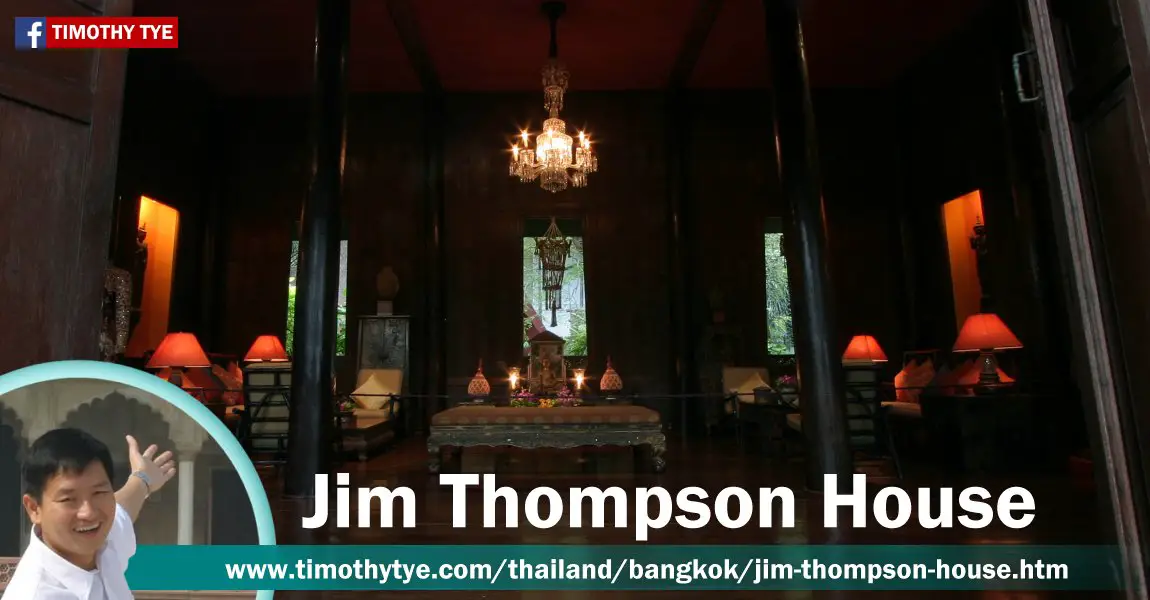 Jim Thompson House, Bangkok, Thailand (31 December, 2002)
Jim Thompson House, Bangkok, Thailand (31 December, 2002)
Jim Thompson House (GPS: xxzz; Thai: พิพิธภัณฑ์บ้าน จิม ทอมป์สัน
 ) is a museum of traditional Thai houses in the middle of Bangkok, Thailand. It is located at 6, Soi Kasemsan 2, off Thanon Rama 1 (Rama 1 Road), in downtown Bangkok, a short walking distance from the National Stadium and Siam Square.
) is a museum of traditional Thai houses in the middle of Bangkok, Thailand. It is located at 6, Soi Kasemsan 2, off Thanon Rama 1 (Rama 1 Road), in downtown Bangkok, a short walking distance from the National Stadium and Siam Square.
Address
Jim Thompson House6 Rama 1 Road, Khwaeng Wang Mai,
Khet Pathum Wan, Bangkok 10330, Thailand.
Phone: +66 2 216 7368
Admission fee, as of November 2018, is 200 Baht for adults aged 22 years and above, and 100 Baht for ages 10-21, free admission for children under 10 years accompanied by a parent.
Jim Thompson House is open daily from 9:00am to 6:00pm. Unaccompanied visits are not permitted in the house. Guided tours are available throughout the day in Thai, English, French, Chinese and Japanese.
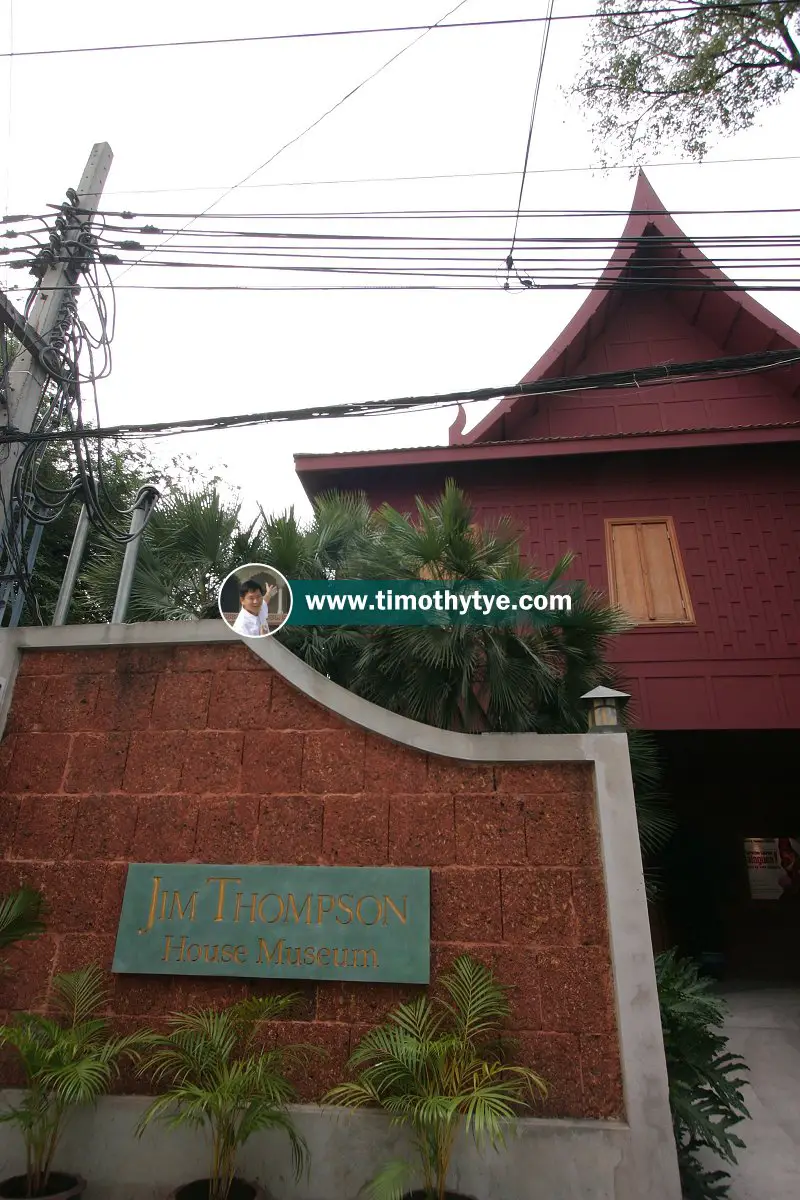 At the entrance to Jim Thompson House Museum (31 December, 2002)
At the entrance to Jim Thompson House Museum (31 December, 2002)
About Jim Thompson House
The ensemble of traditional Thai houses were collected by the late American businessman James Harrison Wilson Thompson who is famous for bringing Thai silk to the world. He disappeared under mysterious circumstances while on holiday in Cameron Highlands, Malaysia. Moonlight Bungalow, the house where he last stayed in Cameron Highlands, is now part of a guesthouse known as Jim Thompson Cottage.Jim Thompson started collecting traditional houses in 1958. The traditional houses - six of them - come from different parts of Thailand with the majority originating from Ayutthaya. The biggest was a weaver's house. It comes from across the canal in neighboring Ban Krua, the Cham Muslim village which is the home of the traditional weavers and where Thompson had his weaving industry.
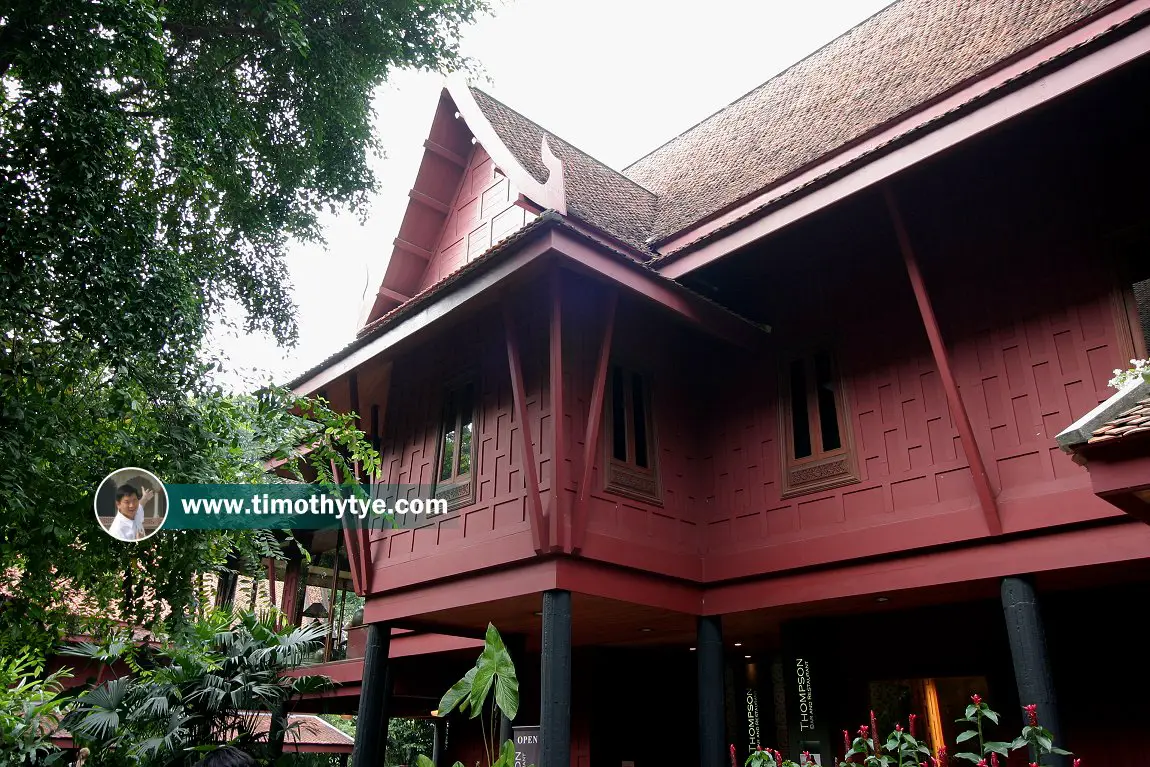 Jim Thompson House. (31 December, 2002)
Jim Thompson House. (31 December, 2002)
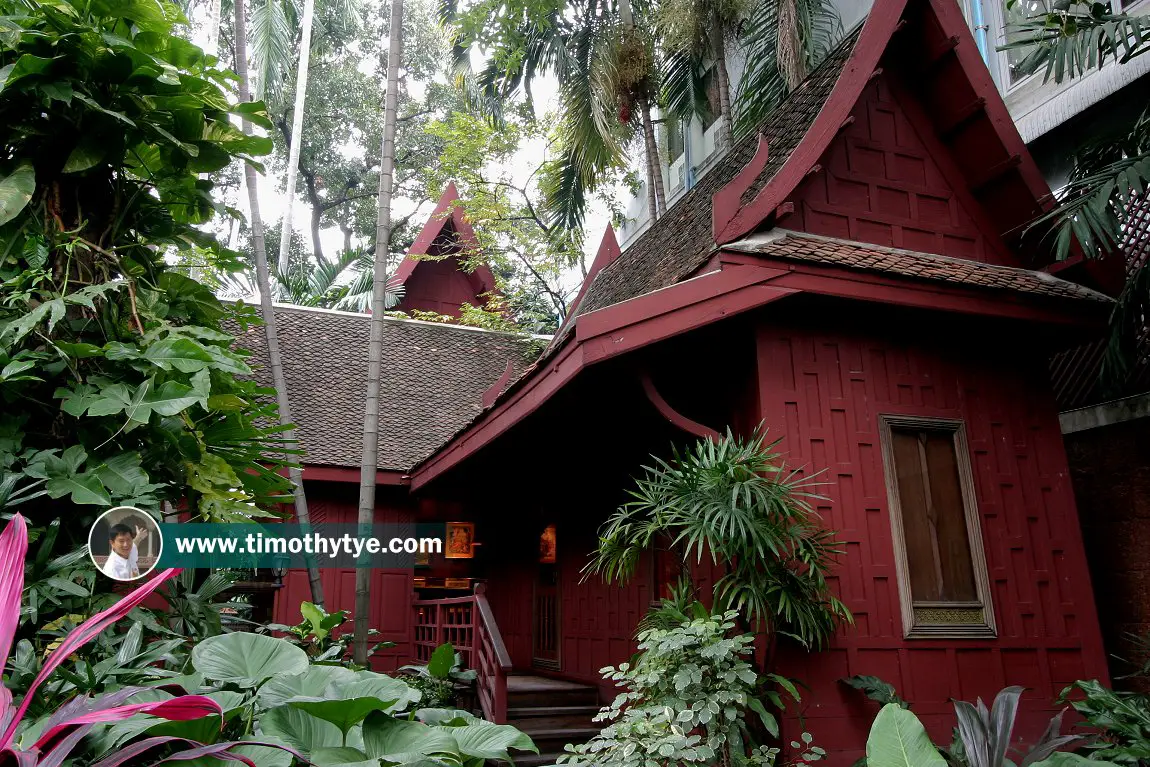 Jim Thompson House is not one, but several traditional Thai houses fused together. (31 December, 2002)
Jim Thompson House is not one, but several traditional Thai houses fused together. (31 December, 2002)
The houses were dismantled and reassembled as a single house in Bangkok. The Ban Krua house came Thompson's living room while the other pieces form other rooms. As the house was assembled from different units, at times an outer wall of an original house now appears as part of the inner wall. In any case, the houses become one single house and is a popular tourist attraction in Bangkok today.
Most of these structures come from Ayutthaya, but the biggest of these - the weaver's house - come from Bangkrua. Today it is the centrepiece, forming the drawing room of the house. As you are taken on a tour of the house, your tour guide will explain to you how, in some instances, the exterior of some houses become the interior, and vice versa. It was a jigsaw puzzle of sorts, as parts of different houses were pieced together to form one big, sprawling house. Jim Thompson brought artisans and carpenters from Ayutthaya to reassemble the structures.
Behind the house is a canal, the Klong Maha Nag (also known as Khlong Saen Saeb), where boats continue to ferry passengers. There is a pier for the house that is no longer in use. On the opposite side of the canal is Bangkrua, a village noted for weaving, where Jim Thompson used to have his silk weaving industry.
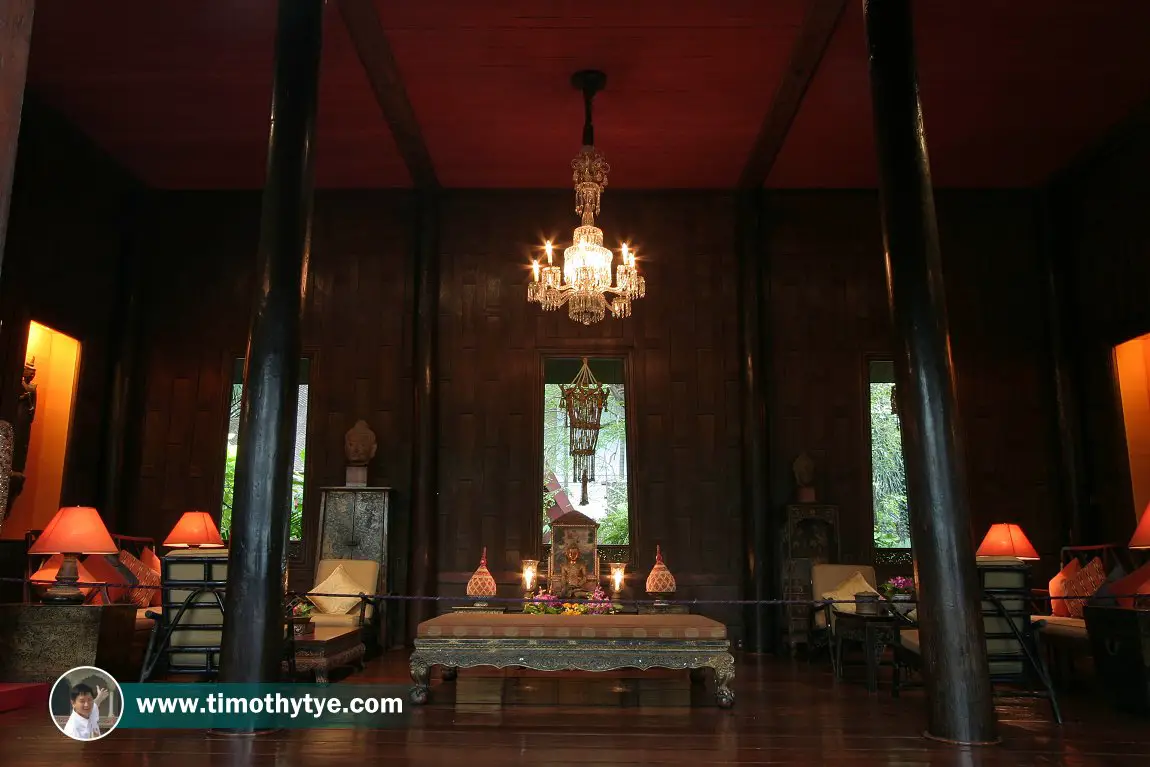 This is the drawing room of Jim Thompson House. (31 December, 2002)
This is the drawing room of Jim Thompson House. (31 December, 2002)
The drawing room (pictured above) is the oldest part of Jim Thompson House, dating to circa 1800. It was originally a house in Bangkrua, which is noted for its weaving community, and of which Jim Thompson spent a considerable amount of time, as he became acquainted with the Thai silk industry.
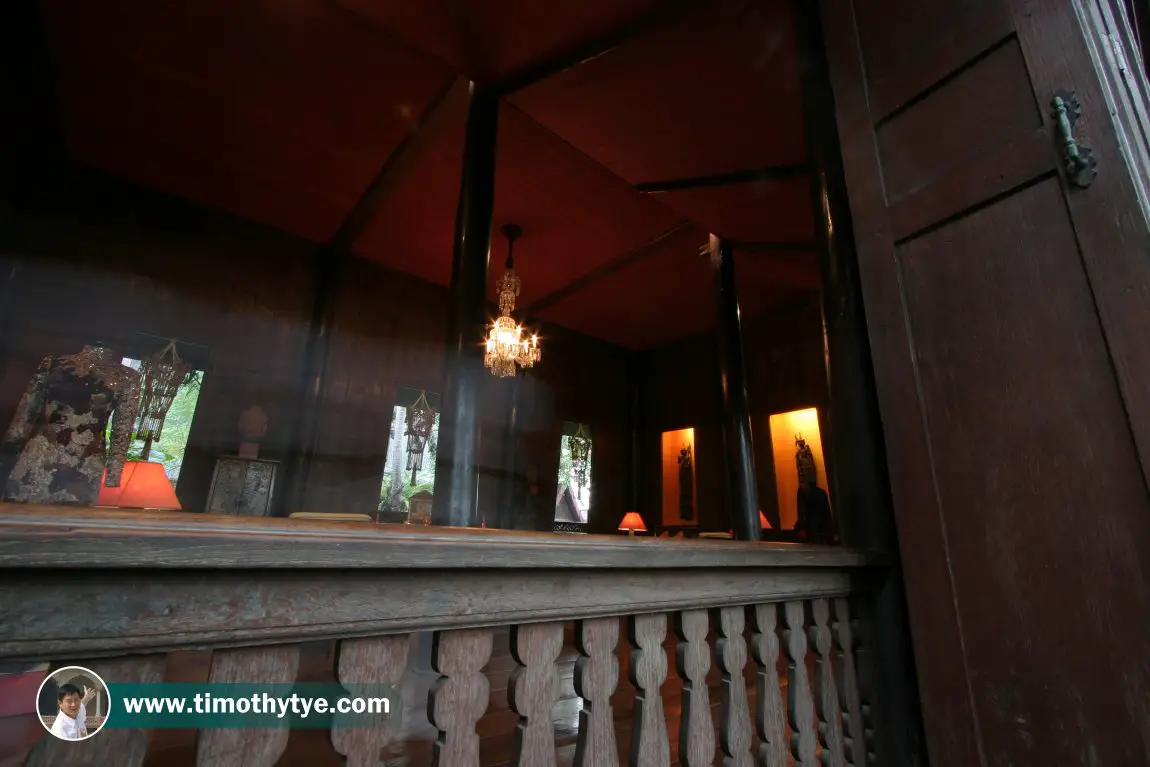 The wooden banisters of the drawing room. (31 December, 2002)
The wooden banisters of the drawing room. (31 December, 2002)
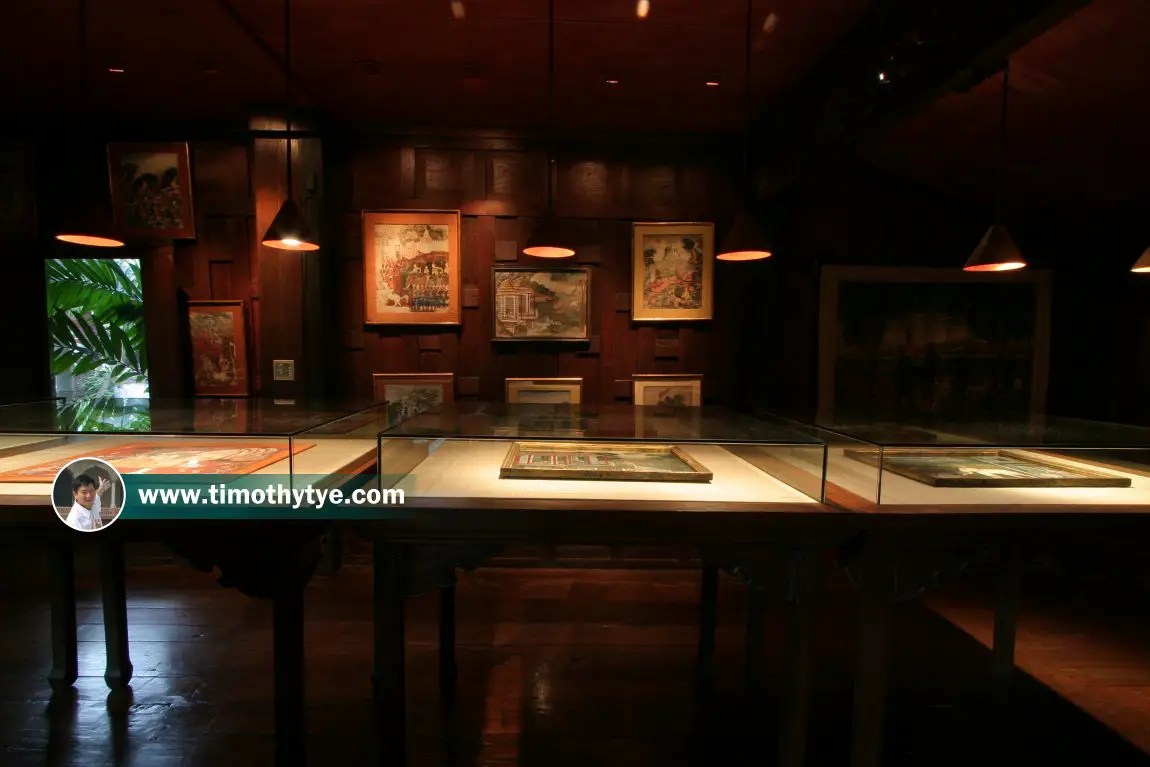 Jim Thompson's exquisite collection of Thai pantings, some going back to the 18th century and earlier. (31 December, 2002)
Jim Thompson's exquisite collection of Thai pantings, some going back to the 18th century and earlier. (31 December, 2002)
The Garden
When Jim Thompson planned his house, he also planned the garden. This we know from the letter he wrote to his sister Elinor, where he showed her a sketch of both the rooms as well as the layout of the garden. He also planned for a lawn facing the khlong (in this case, the Khlong Saem Saep. However, that lawn was not to be. Even before construction work got underway, he had changed his mind about the lawn, and with it removed from plans, there was more space for the terrace.Even as the various traditional houses were brought to the site, there were already trees on the plot, including a large raintree (Samanea Saman) which is carefully protected against construction damage. Thompson was an enthusiastic gardener. Even before this present house was completed, he was already into gardening, albeit on a more modest scale, in his earlier Bangkok house, where he grew the plants and trees indigenous to the tropical climate.
With this new home, and a much larger space to play with, Thompson was able to be more ambitious in his gardening. He also experimenting in trying to grow plants from the temperate climate, though often meeting with disappointing results. Some of the plants that you will see at Jim Thompson House today are later additions, as these garden plants have yet been introduced to Thailand during Jim Thompson's time.
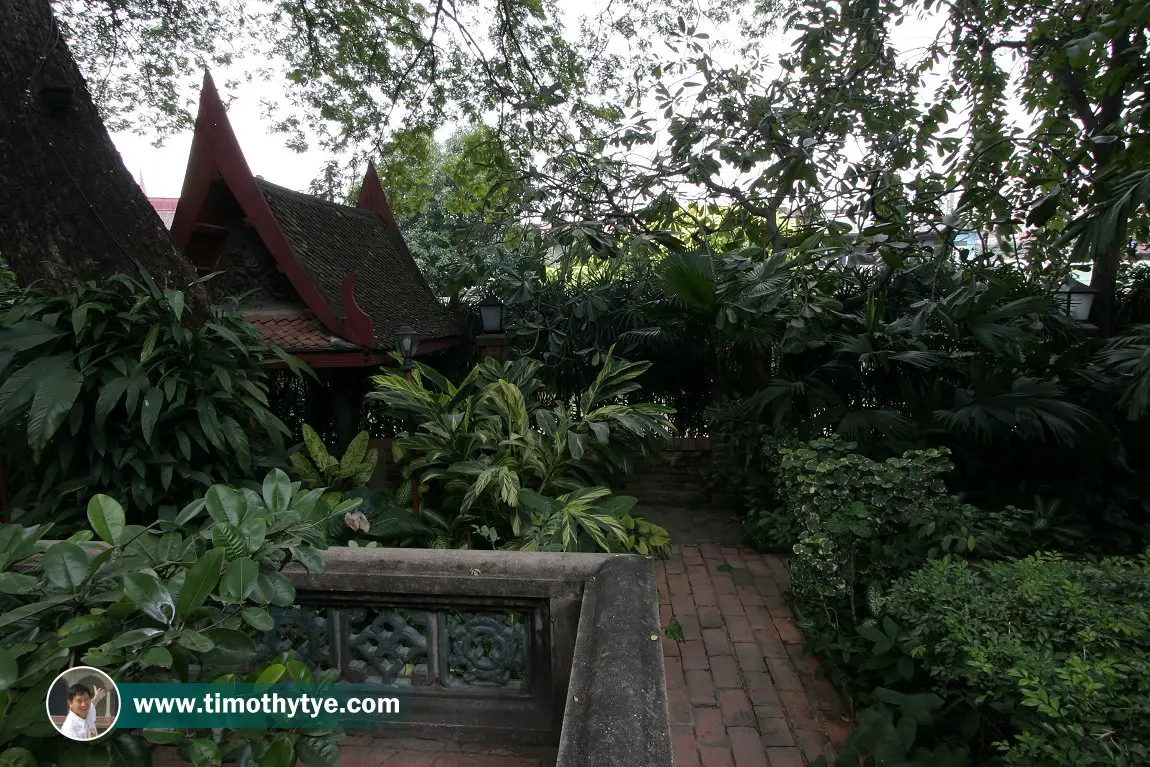 The garden of Jim Thompson House. Noted the garden wall with green glazed tiles often appearing in Chinese houses. (31 December, 2002)
The garden of Jim Thompson House. Noted the garden wall with green glazed tiles often appearing in Chinese houses. (31 December, 2002)
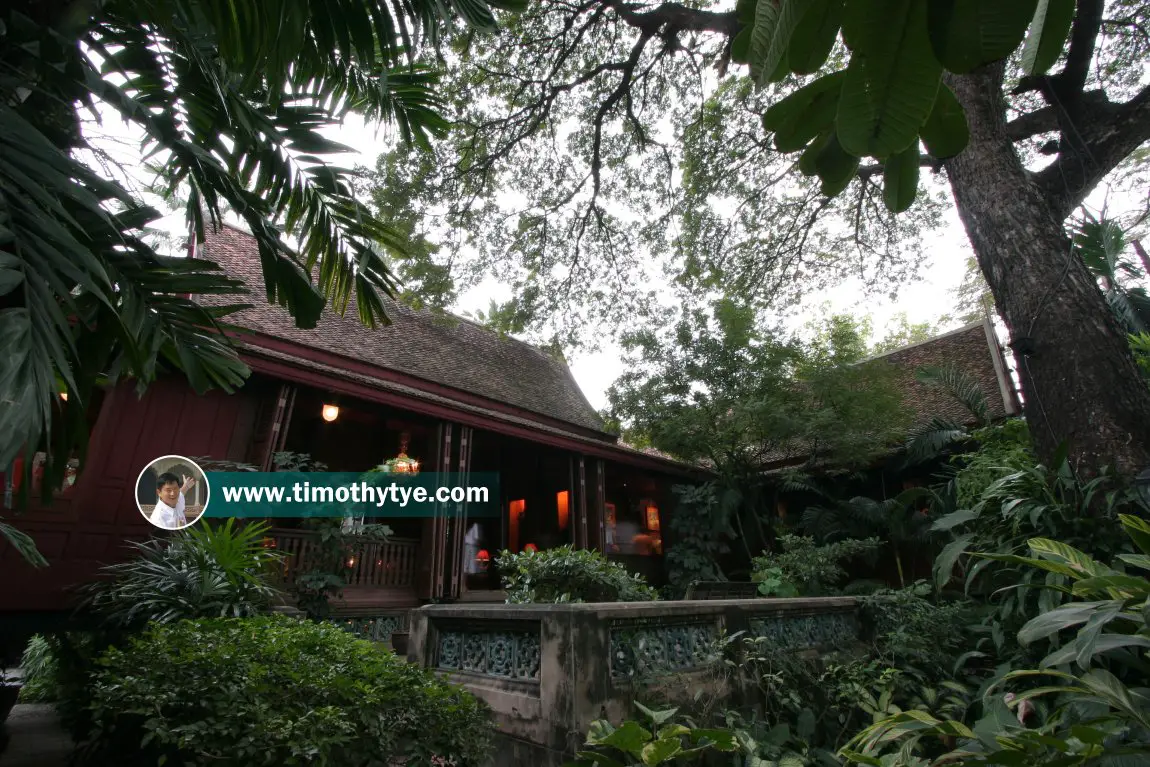 View from the garden towards the drawing room of Jim Thompson House. The garden area is an oasis of greenery within the bustling metropolis. (31 December, 2002)
View from the garden towards the drawing room of Jim Thompson House. The garden area is an oasis of greenery within the bustling metropolis. (31 December, 2002)
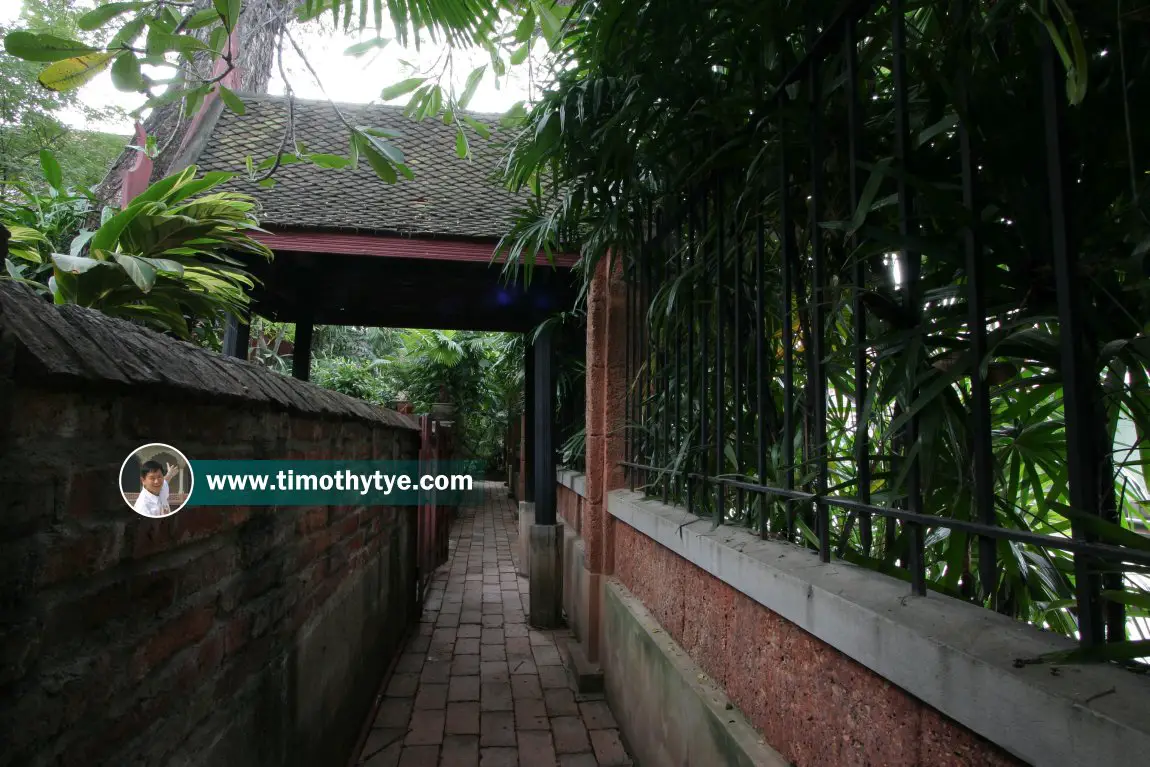 A narrow passage in the garden between the inner and outer wall. On the other size of the left wall is a pathway beside Khlong Saen Saep. (31 December, 2002)
A narrow passage in the garden between the inner and outer wall. On the other size of the left wall is a pathway beside Khlong Saen Saep. (31 December, 2002)
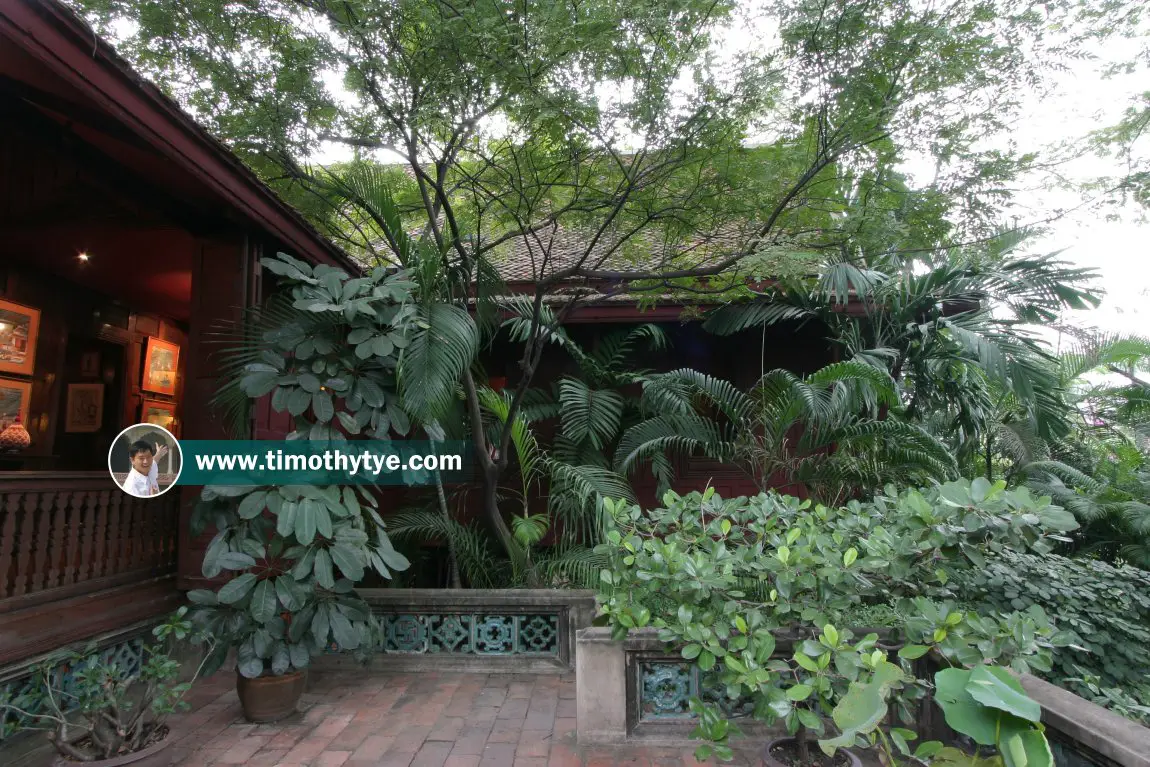 In a tropical climate, growth is constant. (31 December, 2002)
In a tropical climate, growth is constant. (31 December, 2002)
What Jim Thompson discovered is that in a tropical climate, plant growth is constant. So garden work is a regular thing here, to prevent the vegetation from completely choking the house. Maintenance is such that the pruning and weeding should not leave visible scars to the otherwise controlled nature. Even so, by the mid-1990s, a few of the large trees had to be removed, as they have outgrown the area.
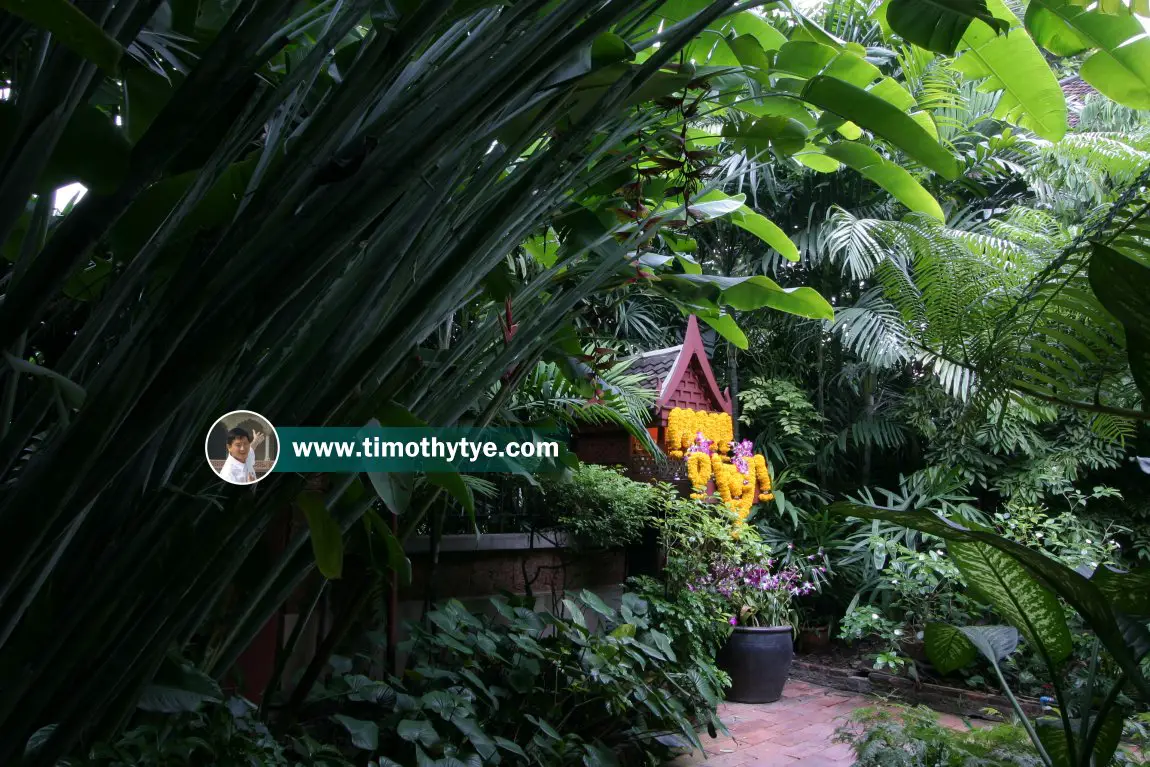 As would be in all Thai houses, there is a spirit house in the garden. (31 December, 2002)
As would be in all Thai houses, there is a spirit house in the garden. (31 December, 2002)
In the earlier stage, Jim Thompson added a few ornamental pieces, to create a "sculptured garden". However, he soon felt that they did not quite fit the surroundings. So these pieces were removed, leaving only the old water jars. You can see these pieces still, in the area beneath the house.
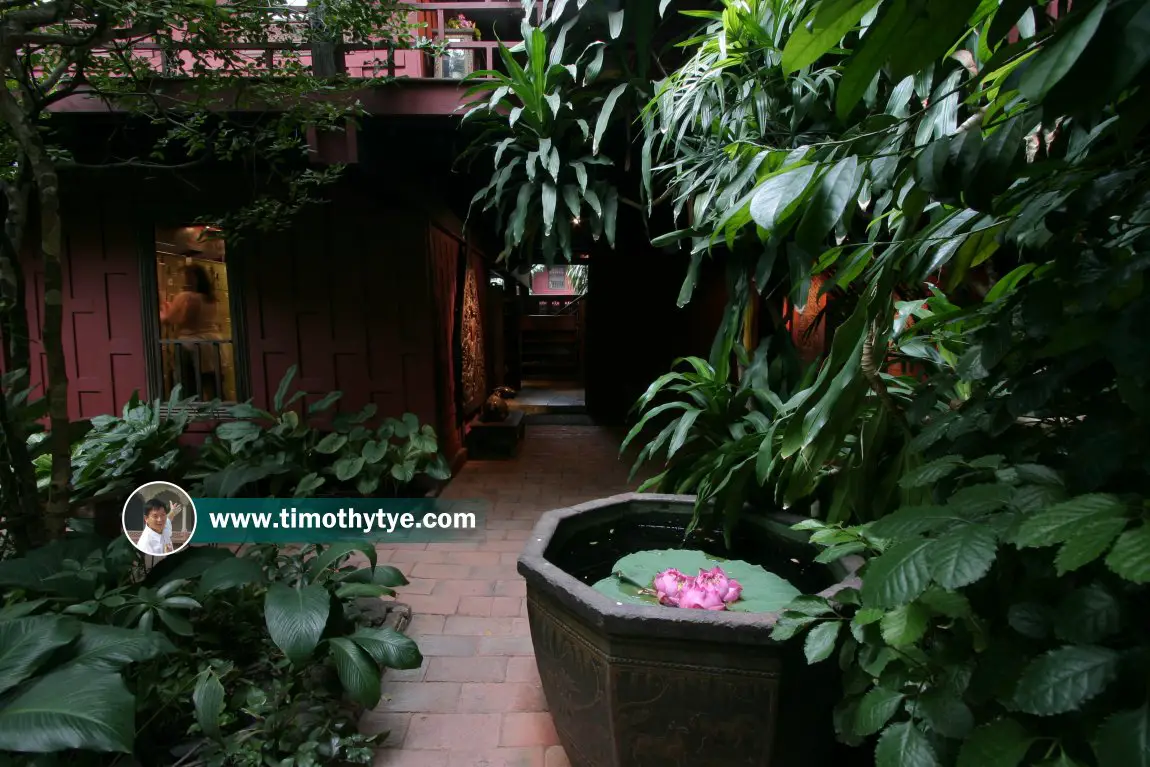 The old water jars are the only ornamental pieces left in the garden. (31 December, 2002)
The old water jars are the only ornamental pieces left in the garden. (31 December, 2002)
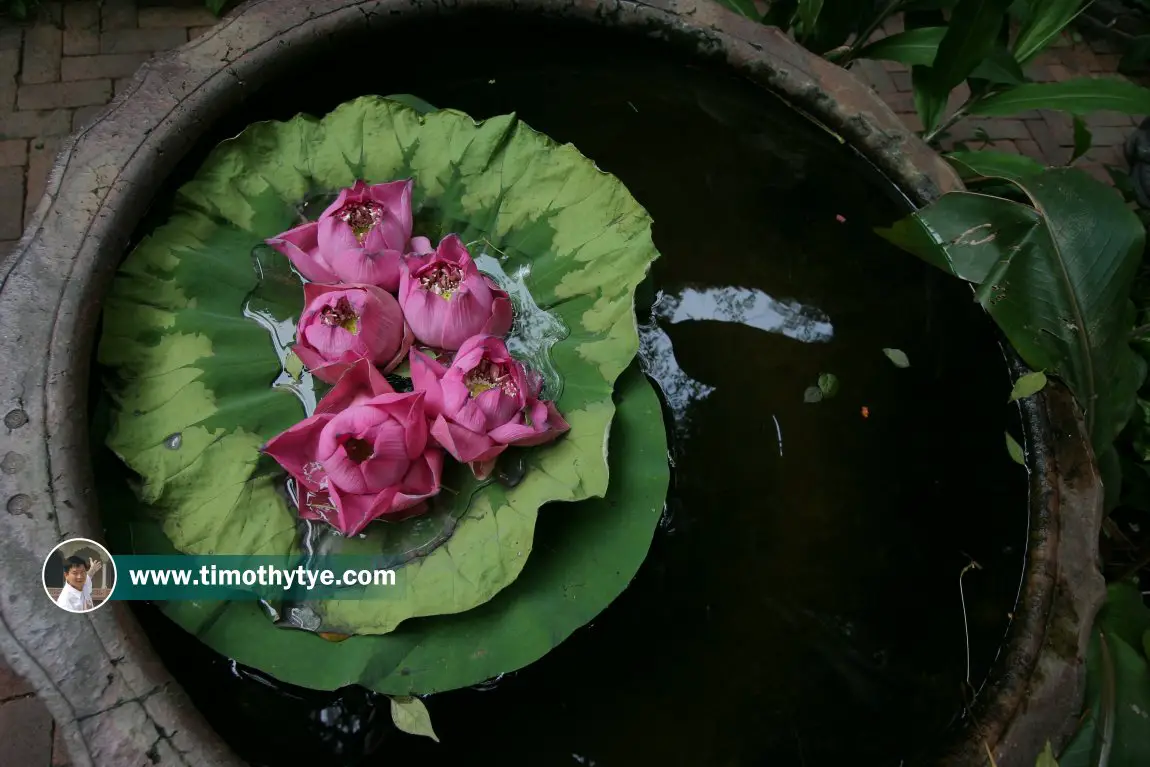 Lotuses bloom in the garden of Jim Thompson House. (31 December, 2002)
Lotuses bloom in the garden of Jim Thompson House. (31 December, 2002)
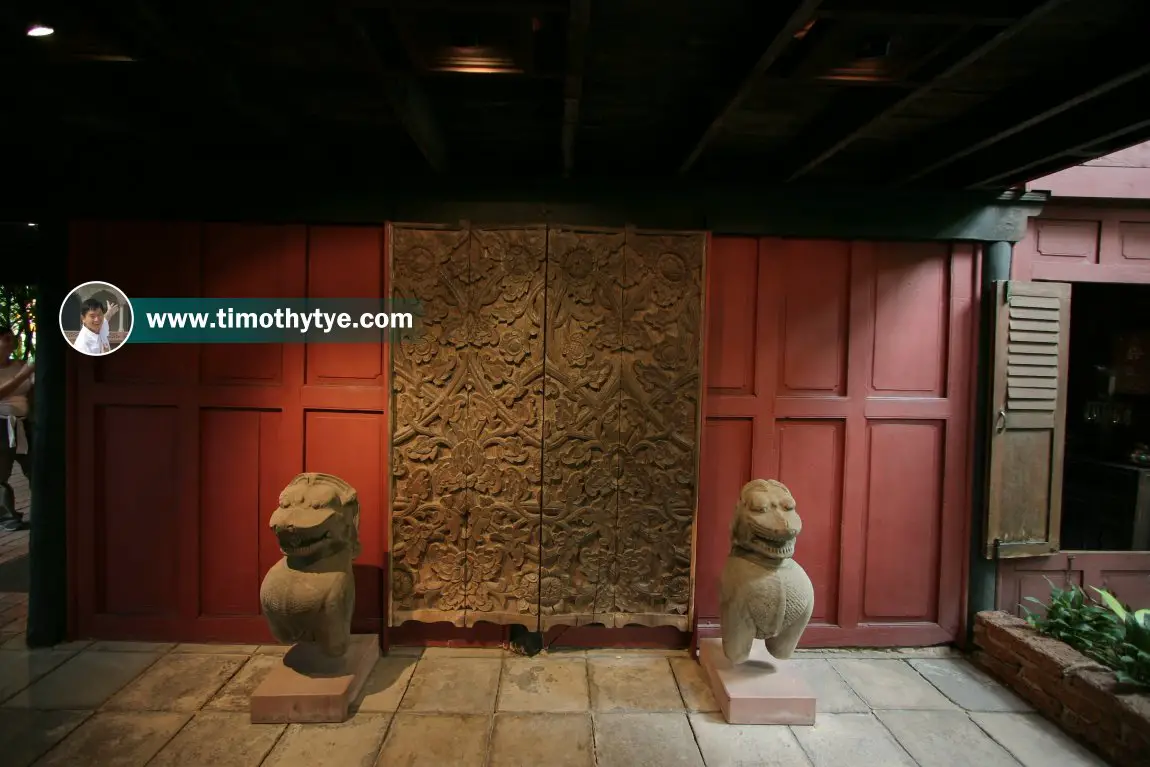 Stone Khmer guardian lions, originally in the garden, were eventually relocated beneath the house. (31 December, 2002)
Stone Khmer guardian lions, originally in the garden, were eventually relocated beneath the house. (31 December, 2002)
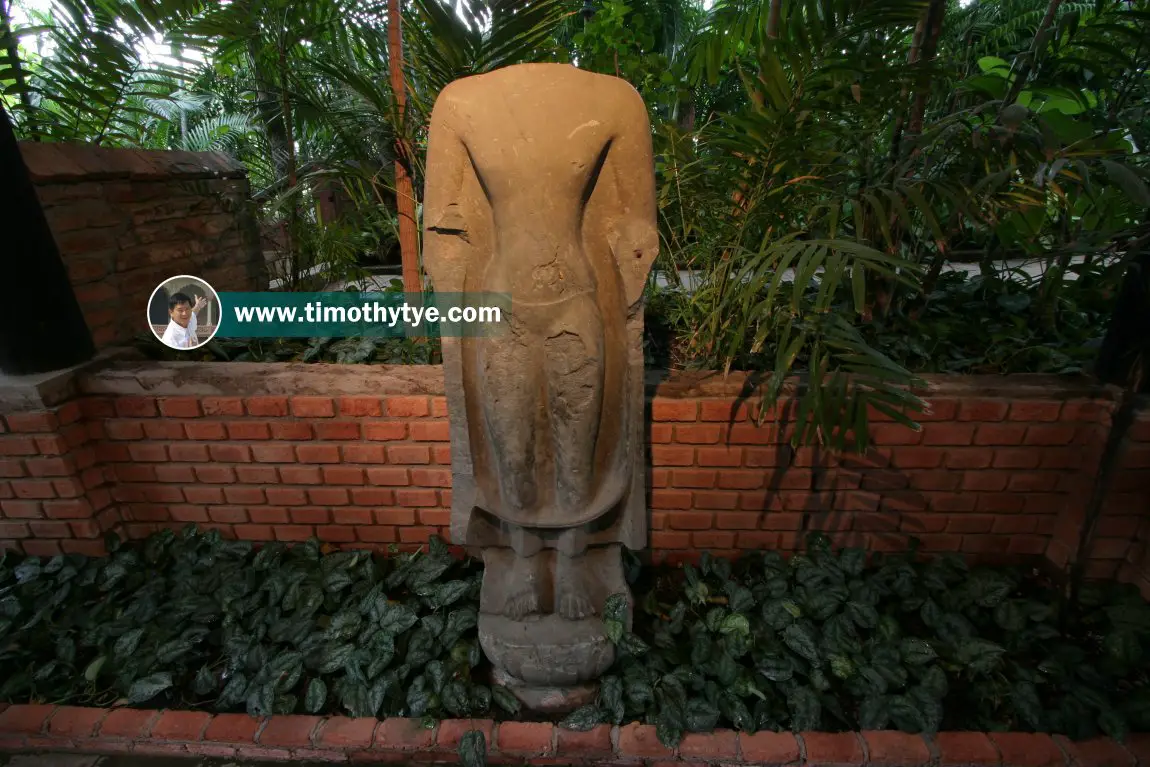 This Buddha torso, a late 7th century antique came from Lopburi Province. Its style is of the Dvaravati school. (31 December, 2002)
This Buddha torso, a late 7th century antique came from Lopburi Province. Its style is of the Dvaravati school. (31 December, 2002)
Jim Thompson Bar and Restaurant
When you are done exploring Jim Thompson House, you can catch a bite at the Bar & Restaurant.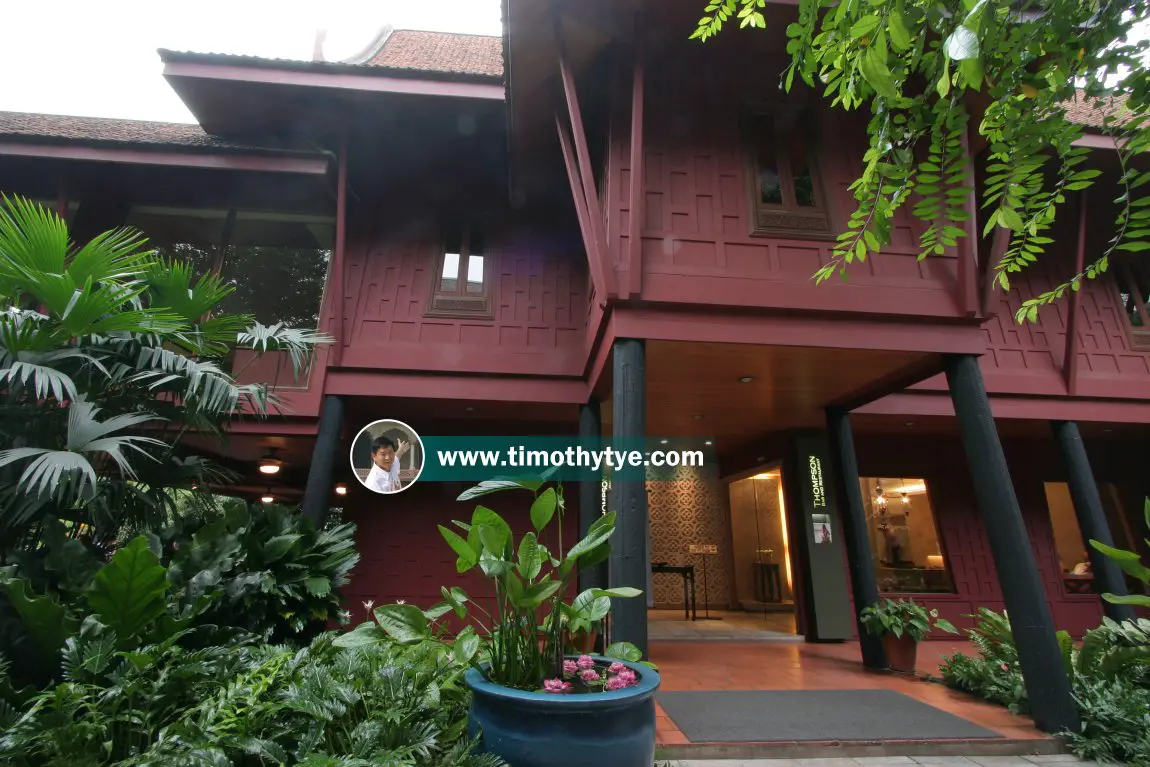 Jim Thompson Bar & Restaurant. (31 December, 2002)
Jim Thompson Bar & Restaurant. (31 December, 2002)
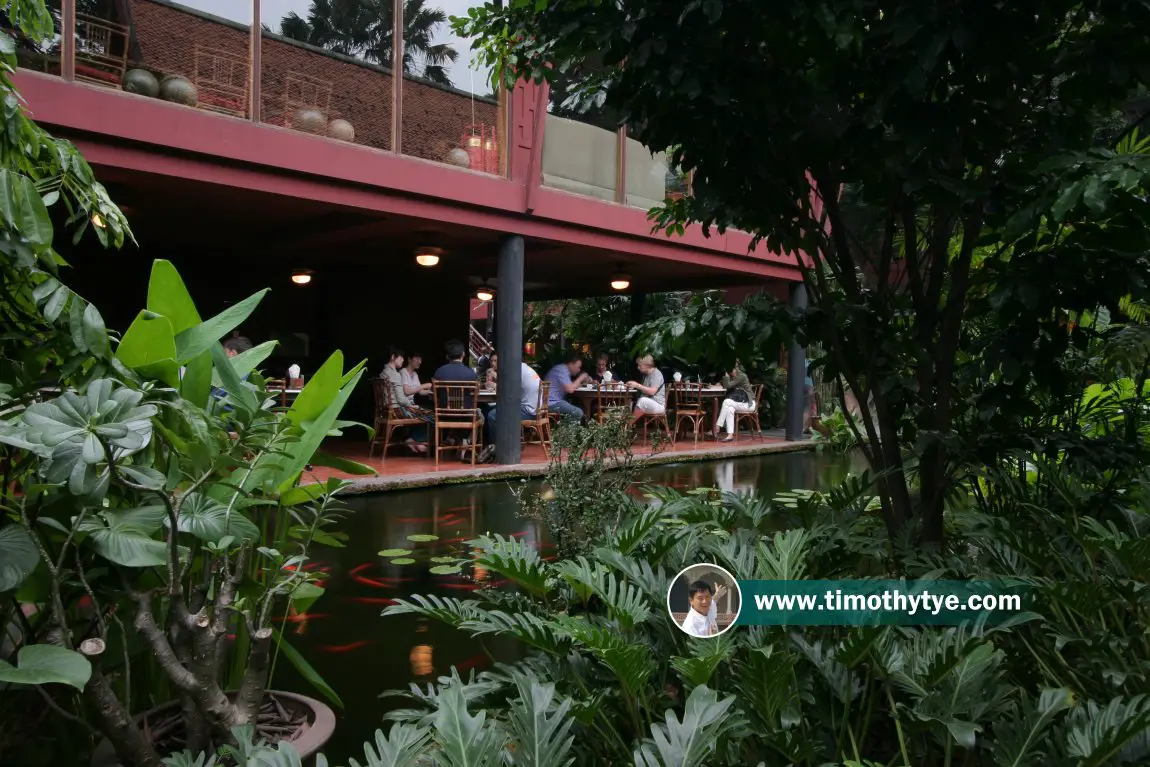 Visitors at the Jim Thompson Bar & Restaurant, with koi pond next to it. (31 December, 2002)
Visitors at the Jim Thompson Bar & Restaurant, with koi pond next to it. (31 December, 2002)
Jim Thompson House on Google Street View
Entrance to Jim Thompson House (Nov 2017)Interior of Jim Thompson House
Getting there
The easiest way is to take the BTS Skytrain Silom Line to the National Stadium (W1) Station. From there, walk to Jim Thompson House, which is at the end of Kasemsan Soi (lane) 2. The house is open daily from 9:00am to 5:00pm, with the last tour conducted at 4:30pm. Admission fee is 100 baht for adults and 50 baht for students.Jim Thompson House
6 Soi Kasemsan 2, Thanon Rama 1 (Rama 1 Road)
Opening Hours : 9:00am to 5:00pm everyday with the last Guided Tour at 4:30pm*
Entrance fees: Adult 100 baht; Students 50 baht
Tel: (662) 216-7368
Fax: (662) 612-3744
Jim Thompson House is  on the Map of Bangkok
on the Map of Bangkok
References
Jim Thompson - The House on the Klong by William Warren & Jean Michel Beurdeley, with photography by Luca Invernizzi Tettoni, © 1999 Editions Didier Millet, ISBN 978-981-4385-89-3List of Historic Buildings in Bangkok; list of Districts of Bangkok
 Latest updates on Penang Travel Tips
Latest updates on Penang Travel Tips
 Map of Roads in Penang
Map of Roads in Penang
Looking for information on Penang? Use this Map of Roads in Penang to zoom in on information about Penang, brought to you road by road.
Copyright © 2003-2025 Timothy Tye. All Rights Reserved.

 , Bangkok
, Bangkok Go Back
Go Back